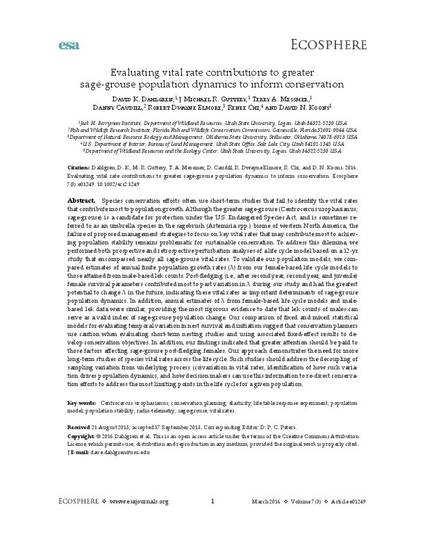
Article
Evaluating Vital Rate Contributions to Greater Sage-grouse Population Dynamics to Inform Conservation
Ecosphere
(2016)
Abstract
Species conservation e orts o en use short-term studies that fail to identify the vital rates that contribute most to population growth. Although the greater sage-grouse (Centrocercus urophasianus; sage-grouse) is a candidate for protection under the U.S. Endangered Species Act, and is sometimes re- ferred to as an umbrella species in the sagebrush (Artemisia spp.) biome of western North America, the failure of proposed management strategies to focus on key vital rates that may contribute most to achiev- ing population stability remains problematic for sustainable conservation. To address this dilemma, we performed both prospective and retrospective perturbation analyses of a life cycle model based on a 12-yr study that encompassed nearly all sage-grouse vital rates. To validate our population models, we com- pared estimates of annual nite population growth rates (λ) from our female-based life cycle models to those a ained from male-based lek counts. Post- edging (i.e., a er second year, second year, and juvenile) female survival parameters contributed most to past variation in λ during our study and had the greatest potential to change λ in the future, indicating these vital rates as important determinants of sage-grouse population dynamics. In addition, annual estimates of λ from female-based life cycle models and male- based lek data were similar, providing the most rigorous evidence to date that lek counts of males can serve as a valid index of sage-grouse population change. Our comparison of xed and mixed statistical models for evaluating temporal variation in nest survival and initiation suggest that conservation planners use caution when evaluating short-term nesting studies and using associated xed-e ect results to de- velop conservation objectives. In addition, our ndings indicated that greater a ention should be paid to those factors a ecting sage-grouse post- edging females. Our approach demonstrates the need for more long-term studies of species vital rates across the life cycle. Such studies should address the decoupling of sampling variation from underlying process (co)variation in vital rates, identi cation of how such varia- tion drives population dynamics, and how decision makers can use this information to re-direct conserva- tion e orts to address the most limiting points in the life cycle for a given population.
Disciplines
Publication Date
2016
DOI
https://doi.org/10.1002/ecs2.1249
Citation Information
Terry A. Messmer. "Evaluating Vital Rate Contributions to Greater Sage-grouse Population Dynamics to Inform Conservation" Ecosphere Vol. 7 Iss. 3 (2016) p. e01249 Available at: http://works.bepress.com/terry-messmer/361/
